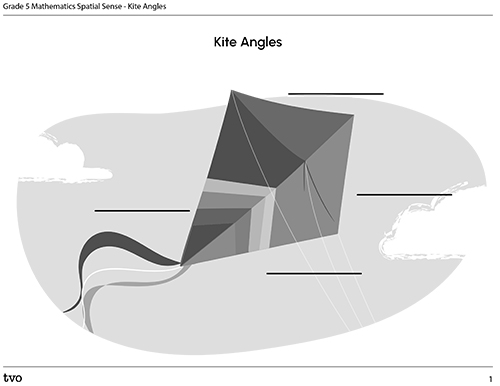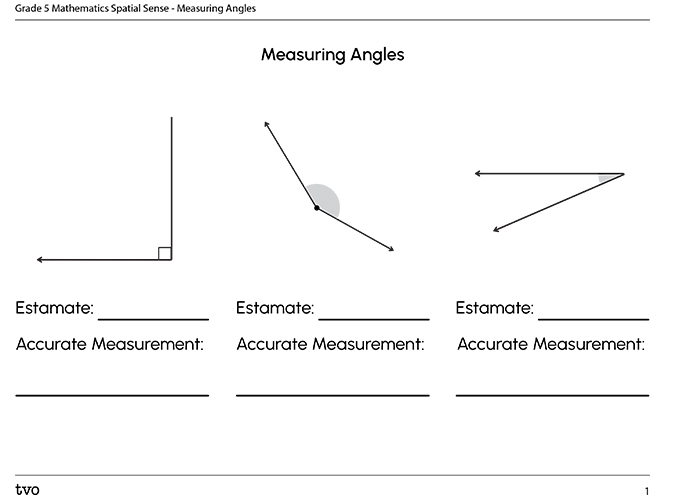Minds On
Clock hands
If we consider a clock, we notice that as the hands of the clock rotate, angles are created between the two hands. Acute, right, obtuse, and straight angles may be recognizable.
Which type of angles are evident at 1 o’clock, 3 o’clock, 8 o’clock, and 6 o’clock?
Record your answers in a notebook or a method of your choice.
Action
Measuring and constructing angles
Task 1: How to measure an angle
Explore this video from Teacher Charmaine about how to measure using a protractor.
After exploring the video, use a notebook or a method of your choice to record a list of steps, which can be used to measure an angle with a protractor.
Task 2: Measuring angles
Use the protractor provided to measure these angles. You can also use a notebook or another method of your choice to record a detailed description on how your would measure these angles.

A pilot flies along the sides of triangle ABC. They start at point A, and fly to point B. Then the pilot turns and flies to point C. At point C, they turn to fly back towards point A.
- What angle did the pilot turn the plane as they left point B and travelled to point C?
- What angle did the pilot turn the plane as they left point C and travelled to point A?
Explain how you determined these two angles.
Record your ideas in a notebook or a method of your choice.
To rotate the protractor input the number of degrees you would like to rotate the protractor by and use the buttons to select the direction of rotation.
Task 3: Constructing an angle
Explore the following video to learn how to construct angles using a protractor and ruler.
What are the important steps to use when constructing an angle of a specific size? Record your thoughts using a method of your choice.
Construct the following angles or describe how you would create each angle. You may need a ruler, a protractor, or another method of your choice.
Record your ideas in a notebook or a method of your choice.
Construct the following angles, or describe the steps required.
- 30°
- 74°
- 17°
- 100°
When you are done constructing the angles, you may explore the following protractor to check your answer.
To rotate the protractor input the number of degrees you would like to rotate the protractor by and use the buttons to select the direction of rotation.
Task 4: Estimating the size of an angle
Examine the following protractor. Notice the position of 0°, 45°, 90°, 135°, and 180°. These angles are called benchmark angles, because they can be helpful to estimate the measurement of other angles when you don’t have access to a protractor. By comparing an angle to these benchmark angles and judging whether it is smaller or larger than the benchmark angle, you can estimate the size of the angle.

A protractor with two rows of numbers. The top row starts at 180 degrees on the right and counts back by tens to 0. The second row starts at 0 degrees on the right and ends at 180 on the left. Each value from the two curves is stacked above each other. Highlighted are benchmark angles: 0, 45, 90, 135, and 180 degrees. 0 degrees and 180 degrees make a straight line. 45 degrees is an acute angle. 90 degrees is a right angle. 135 degrees is an obtuse angle.
How could you estimate the size of these angles? Which of the benchmark angles could you use to estimate their size? Using pencil and paper, a computer, or a voice recorder, explain how you would estimate the size of these two angles.
Consolidation
Measuring kite angles
Task 1: Independent practice
A kite maker is designing a four-sided kite. Use a protractor or digital tool to measure, or describe in detail how to measure, the four angles inside the kite. Record your response using a method of your choice or using the following fillable and printable Kite Angles diagram.
You may use the following kite provided to measure angles or create your own design and angles. To rotate the protractor input the number of degrees you would like to rotate the protractor by and use the buttons to select the direction of rotation.
Did you find acute, obtuse, and right angles in the kite?
To rotate the protractor input the number of degrees you would like to rotate the protractor by and use the buttons to select the direction of rotation.
Task 2: Measuring with benchmark angles
Use the benchmark angles to estimate the measurement of each angles. Then, use a protractor or another measurement tool to measure these angles. You may also describe in detail how to measure the angles in a a method of your choice.
Complete the Measuring Angles in your notebook or using the following fillable and printable documents. You can also use another method of your choice.
Task 3: Discussing angles
Consider the following description and/or image of an angle stated to be 60°, and determine whether the angle is being measured accurately. Explain or describe what the measurement of this angle is, and the strategies which can be used to create a 60° angle. Record you thoughts using a method of your choice.
A protractor with two rows of numbers. The top row starts at 180 degrees on the right and counts backwards by tens to 0. The second row starts at 0 degrees on the right and ends at 180 on the left. Each value from the two curves is stacked above each other. The protractor is placed on the vertex of two line segments of an obtuse angle. With the protractor, two numbers are indicated; 60 degrees on top and 120 degrees on the bottom.
Reflection
As you read through these descriptions, which sentence best describes how you are feeling about your understanding of this learning activity? Press the button that is beside this sentence.
I feel...
Now, record your ideas using a voice recorder, speech-to-text, or writing tool.
Connect with a TVO Mathify tutor
Think of TVO Mathify as your own personalized math coach, here to support your learning at home. Press ‘TVO Mathify’ to connect with an Ontario Certified Teacher math tutor of your choice. You will need a TVO Mathify login to access this resource.
TVO Mathify (Opens in a new tab)
